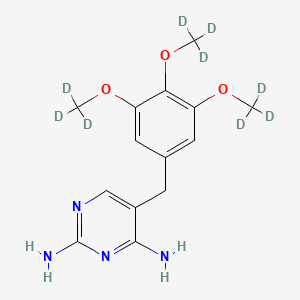
Trimethoprim-d9
Vue d'ensemble
Description
Trimethoprim-d9 (Major), also known as this compound (Major), is a useful research compound. Its molecular formula is C14H18N4O3 and its molecular weight is 299.378. The purity is usually 95%.
BenchChem offers high-quality this compound (Major) suitable for many research applications. Different packaging options are available to accommodate customers' requirements. Please inquire for more information about this compound (Major) including the price, delivery time, and more detailed information at [email protected].
Applications De Recherche Scientifique
Antibactérien
Trimethoprim est un ancien médicament antibactérien qui a été utilisé comme modèle pour la recherche de nouvelles cibles . Il a été utilisé dans la synthèse de nouveaux analogues de trimethoprim . Ces analogues ont montré une affinité accrue pour la dihydrofolate réductase (DHFR), une enzyme qui joue un rôle crucial dans le métabolisme du folate .
Agents de liaison à l'ADN
Les analogues de trimethoprim ont été trouvés pour avoir une capacité de liaison à l'ADN . Des tests confirmant la possibilité de liaison à l'ADN dans un sillon mineur ont été effectués en utilisant différents types d'ADN . Cette propriété pourrait être utile dans le développement de nouveaux agents thérapeutiques.
Inhibition des enzymes du métabolisme du folate
Le métabolisme du folate est une cible importante pour le développement d'agents thérapeutiques contre les infections bactériennes et parasitaires, ainsi que pour la thérapie contre le cancer . Trimethoprim inhibe la DHFR, une enzyme essentielle dans le métabolisme du folate . Cette inhibition perturbe la réplication de l'ADN et provoque finalement la mort cellulaire .
Développement d'agents thérapeutiques
Le mode des ligands multiples conçus pourrait offrir plusieurs avantages potentiels, tels que l'augmentation de l'efficacité thérapeutique ou la diminution de la résistance aux médicaments anticancéreux . Trimethoprim pourrait être utilisé dans le développement de ces ligands.
Détermination spectrométrique
Trimethoprim peut être déterminé par des techniques spectrométriques
Mécanisme D'action
Target of Action
Trimethoprim-d9, also known as this compound (Major), primarily targets the bacterial enzyme dihydrofolate reductase (DHFR) . DHFR is a critical enzyme that catalyzes the formation of tetrahydrofolic acid (THF), an essential precursor in the biosynthesis of nucleic acids .
Mode of Action
this compound inhibits DHFR, thereby preventing the synthesis of bacterial DNA and ultimately leading to bacterial death . It binds with a much stronger affinity to bacterial DHFR compared to its mammalian counterpart, allowing this compound to selectively interfere with bacterial biosynthetic processes .
Biochemical Pathways
The inhibition of DHFR by this compound disrupts the biosynthesis pathways of thymidylate and purines, as well as several other amino acids like glycine, methionine, serine, and N-formyl-methionyl tRNA . This leads to an imbalance in the pathways involved in active synthesizing thymidylate, disrupts DNA replication, and eventually causes cell death .
Pharmacokinetics
this compound is a potent inhibitor of multidrug and toxin extrusion protein (MATE) and a weak inhibitor of cytochrome P450 (CYP) 2C8 . These properties can influence the absorption, distribution, metabolism, and excretion (ADME) of the compound, impacting its bioavailability .
Result of Action
The molecular and cellular effects of this compound’s action include the inhibition of bacterial DNA synthesis, leading to bacterial death . Some of the new analogs of this compound inhibited DHFR activity more strongly than Trimethoprim did, indicating that the addition of amide bonds into the analogs of this compound increases their affinity towards DHFR .
Action Environment
Environmental factors can influence the action, efficacy, and stability of this compound. For instance, pH plays a role in the mode of action of this compound on Escherichia coli . Moreover, soil-related factors, animal husbandry and waste management, potable and wastewater, and food safety can contribute to antimicrobial resistance . These factors need to be considered in modeling the fate and transport of this compound in coastal/estuarine waters .
Analyse Biochimique
Biochemical Properties
Trimethoprim-d9 interacts with the enzyme dihydrofolate reductase (DHFR), which plays a crucial role in the biosynthesis pathways of thymidylate, purines, and several amino acids . The interaction between this compound and DHFR inhibits the enzyme’s activity, disrupting DNA replication and eventually leading to cell death .
Cellular Effects
The effects of this compound on cells are primarily due to its inhibition of DHFR. This disruption in folate metabolism leads to an imbalance in the pathways involved in synthesizing thymidylate, which is essential for DNA replication . As a result, the function of cells is significantly affected, leading to cell death .
Molecular Mechanism
This compound exerts its effects at the molecular level by binding to the DHFR enzyme. This binding inhibits the enzyme’s activity, preventing the reduction of dihydrofolate acid to tetrahydrofolic acid . This disruption in folate metabolism leads to an imbalance in the pathways involved in synthesizing thymidylate, which is essential for DNA replication .
Metabolic Pathways
This compound is involved in the folate metabolism pathway. It interacts with the DHFR enzyme, which catalyzes the reduction of dihydrofolate acid to tetrahydrofolic acid . The inhibition of DHFR by this compound disrupts this metabolic pathway, leading to an imbalance in the pathways involved in synthesizing thymidylate .
Propriétés
IUPAC Name |
5-[[3,4,5-tris(trideuteriomethoxy)phenyl]methyl]pyrimidine-2,4-diamine | |
|---|---|---|
| Source | PubChem | |
| URL | https://pubchem.ncbi.nlm.nih.gov | |
| Description | Data deposited in or computed by PubChem | |
InChI |
InChI=1S/C14H18N4O3/c1-19-10-5-8(6-11(20-2)12(10)21-3)4-9-7-17-14(16)18-13(9)15/h5-7H,4H2,1-3H3,(H4,15,16,17,18)/i1D3,2D3,3D3 | |
| Source | PubChem | |
| URL | https://pubchem.ncbi.nlm.nih.gov | |
| Description | Data deposited in or computed by PubChem | |
InChI Key |
IEDVJHCEMCRBQM-GQALSZNTSA-N | |
| Source | PubChem | |
| URL | https://pubchem.ncbi.nlm.nih.gov | |
| Description | Data deposited in or computed by PubChem | |
Canonical SMILES |
COC1=CC(=CC(=C1OC)OC)CC2=CN=C(N=C2N)N | |
| Source | PubChem | |
| URL | https://pubchem.ncbi.nlm.nih.gov | |
| Description | Data deposited in or computed by PubChem | |
Isomeric SMILES |
[2H]C([2H])([2H])OC1=CC(=CC(=C1OC([2H])([2H])[2H])OC([2H])([2H])[2H])CC2=CN=C(N=C2N)N | |
| Source | PubChem | |
| URL | https://pubchem.ncbi.nlm.nih.gov | |
| Description | Data deposited in or computed by PubChem | |
Molecular Formula |
C14H18N4O3 | |
| Source | PubChem | |
| URL | https://pubchem.ncbi.nlm.nih.gov | |
| Description | Data deposited in or computed by PubChem | |
DSSTOX Substance ID |
DTXSID10662219 | |
| Record name | Trimethoprim-d9 | |
| Source | EPA DSSTox | |
| URL | https://comptox.epa.gov/dashboard/DTXSID10662219 | |
| Description | DSSTox provides a high quality public chemistry resource for supporting improved predictive toxicology. | |
Molecular Weight |
299.37 g/mol | |
| Source | PubChem | |
| URL | https://pubchem.ncbi.nlm.nih.gov | |
| Description | Data deposited in or computed by PubChem | |
CAS No. |
1189460-62-5 | |
| Record name | Trimethoprim-d9 | |
| Source | EPA DSSTox | |
| URL | https://comptox.epa.gov/dashboard/DTXSID10662219 | |
| Description | DSSTox provides a high quality public chemistry resource for supporting improved predictive toxicology. | |
Synthesis routes and methods I
Procedure details








Synthesis routes and methods II
Procedure details





Avertissement et informations sur les produits de recherche in vitro
Veuillez noter que tous les articles et informations sur les produits présentés sur BenchChem sont destinés uniquement à des fins informatives. Les produits disponibles à l'achat sur BenchChem sont spécifiquement conçus pour des études in vitro, qui sont réalisées en dehors des organismes vivants. Les études in vitro, dérivées du terme latin "in verre", impliquent des expériences réalisées dans des environnements de laboratoire contrôlés à l'aide de cellules ou de tissus. Il est important de noter que ces produits ne sont pas classés comme médicaments et n'ont pas reçu l'approbation de la FDA pour la prévention, le traitement ou la guérison de toute condition médicale, affection ou maladie. Nous devons souligner que toute forme d'introduction corporelle de ces produits chez les humains ou les animaux est strictement interdite par la loi. Il est essentiel de respecter ces directives pour assurer la conformité aux normes légales et éthiques en matière de recherche et d'expérimentation.














